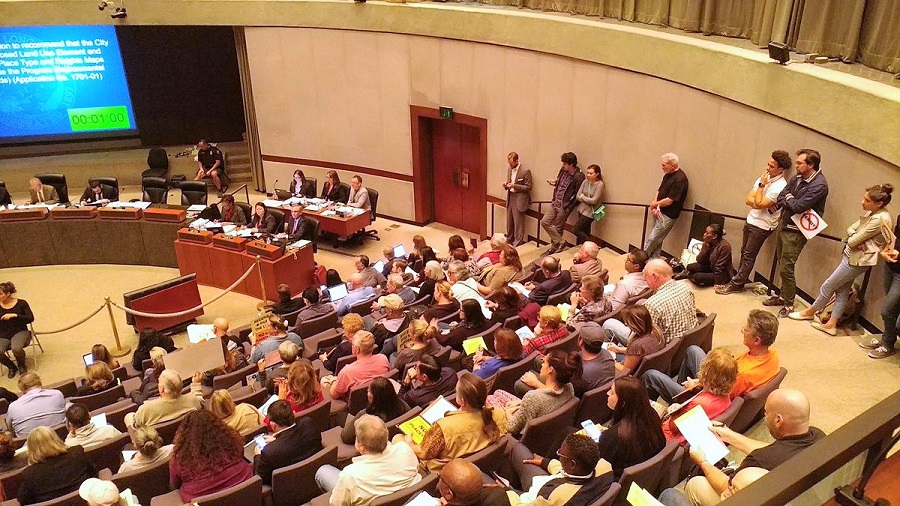
Photo by Michael Garcia.
After hours of deliberation and public comment the Long Beach Planning Commission voted Monday to forward a contentious land use planning document to the city council, ending months of public meetings that pitted homeowners against city staff.
The land use element (LUE) entered the realm of controversy over the summer as residents became aware of the city’s updating of its general plan, which includes the land use and urban design elements, as it plans for the city’s growth over the next four decades. The commission’s vote that came late into the night reflected another small victory for residents who have loudly denounced the plan as the commission eroded some of the already reduced allowable building heights in the LUE.
Contentious areas of planned allowable density and building heights like the shopping center at Bellflower Boulevard and Spring Street—the site currently holds a K-Mart and Lowe’s Home Improvement—a separate site at Bellflower Boulevard and Stearns Street (where a Sears is located), areas surrounding the Traffic Circle, and a strip along Seventh Street between Walnut and St. Louis streets all saw reductions in allowable heights with commissioners requesting that the council not allow mixed use or outright residential uses at Bellflower/Spring, Bellflower/Stearns and parts of the Traffic Circle sites.
Council districts One, Three, Seven, Eight and Nine all remained untouched from when the city released updated land use maps in early November.
“I know that not everyone is happy with everything that was done,” said Erick Verduzco-Vega, the planning commission chair, as he advised the crowd that their opportunity to provide further input did not end with Monday’s vote. “This item is not finalized. Our action tonight is simply a recommendation to the city council. It is not a final action.”
The planning commission previously voted to send the LUE back to city staff during a meeting in August, where outgoing Director of Development Services Amy Bodek now infamously advised the commission that she was taking the LUE to the city council “with or without” their approval.
Mayor Robert Garcia stepped in after that vote and requested a series of outreach meetings be held regarding the LUE, with the last public meeting prior to the council’s consideration of the document occurring Monday night. Hundreds of residents turned out to four official public meetings regarding the LUE and ultimately resulted in the city scaling back some of the proposed density projections, of which many residents expressed would detrimentally affect quality of life and the character of their neighborhoods.
Monday night’s meeting, which spanned over six hours, is not the final vote on the LUE. Multiple city council members have been vocal about changes that will likely happen once it comes back to the council chambers for their review.
That did not stop the waves of Long Beach homeowners from voicing their concerns one last time before the plan heads to the council. The four hours of overwhelming dissent to the LUE seemingly impacted the planning commissioners’ decision as they undertook a last-minute round of cuts to height allotments prior to their vote.
Mike Hazlewood, a Lakewood Village resident, said he opposes the plan because the planning documents didn’t take into account the impact on communities, namely traffic impacts and how increased density could affect parking. Like many others, Hazlewood accused the city of not having adequate outreach efforts to engage the community prior to finalizing the LUE.
“I don’t think anyone here is opposed to growth,” Hazlewood said. “What we’re opposed to is the way that this has been approached.”
While outnumbered in the overflow crowd that packed city hall Monday night, a smaller contingent of residents asking the commission to pass the LUE on to the city council stated their case. Many pointed to the city’s shrinking stock of affordable housing as an imperative for the city to pass a plan that could potentially alleviate its housing stock shortage, while others noted a growing population of seniors that could soon join the city’s homeless population if they continue to be displaced by rising rents in the city.
LUE advocates young and old cast the the struggle as that of the haves and have nots, and of older residents against younger generations. One man who identified himself as Jason, said that he recently moved to Long Beach because he found it more affordable than other cities although he said that situation is quickly changing.
“I’ve basically given up the hope of ever owning a home or any significant unit, it’s very unattainable,” he said, adding that his move to Long Beach was prompted by his belief that it had progressive planning values. “Long Beach has an opportunity to implement those things and to be an exciting place to live. You’re faced with a choice, you can plan for the generation that is already here, and already has a home and is established, or you plan for people like me.”
Long Beach, like much of the state, is facing a deficit in housing units overall, in particular those that are considered to be affordable. With the commission’s vote Monday night it’s unclear how many of the projected units could be slashed by its recommendation to the council to reduce certain allowable building heights throughout the city.
As the LUE moves on to the city council sometime in the new year, further edits to the land use maps and allowable densities and building heights could change yet again once the documents move into that phase of the general plan update.

